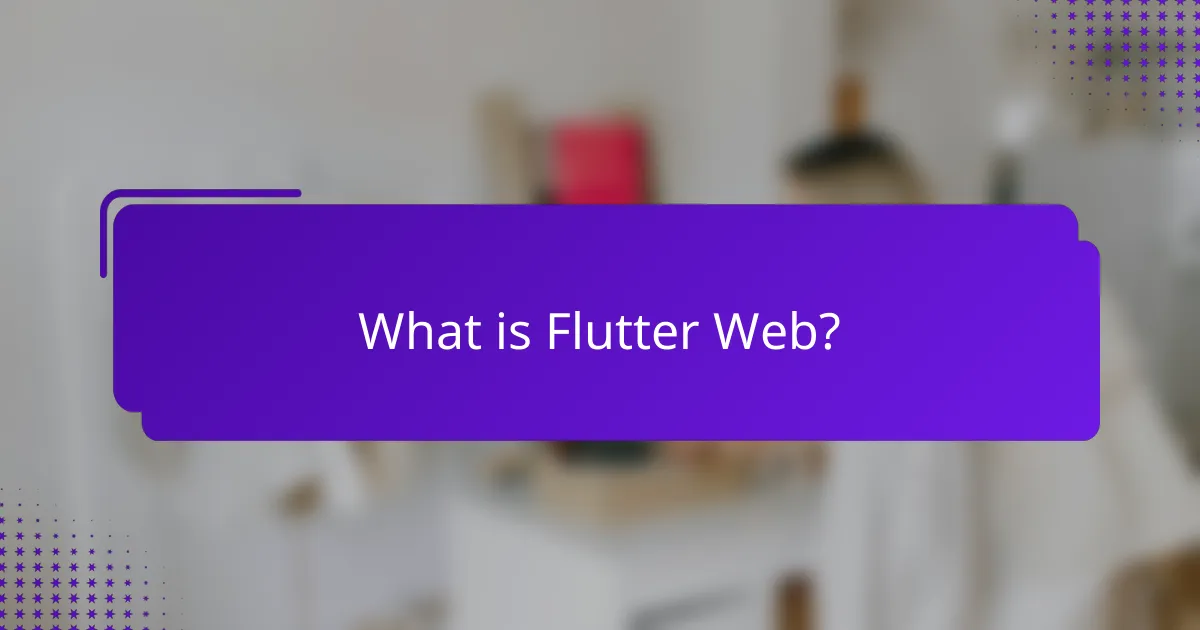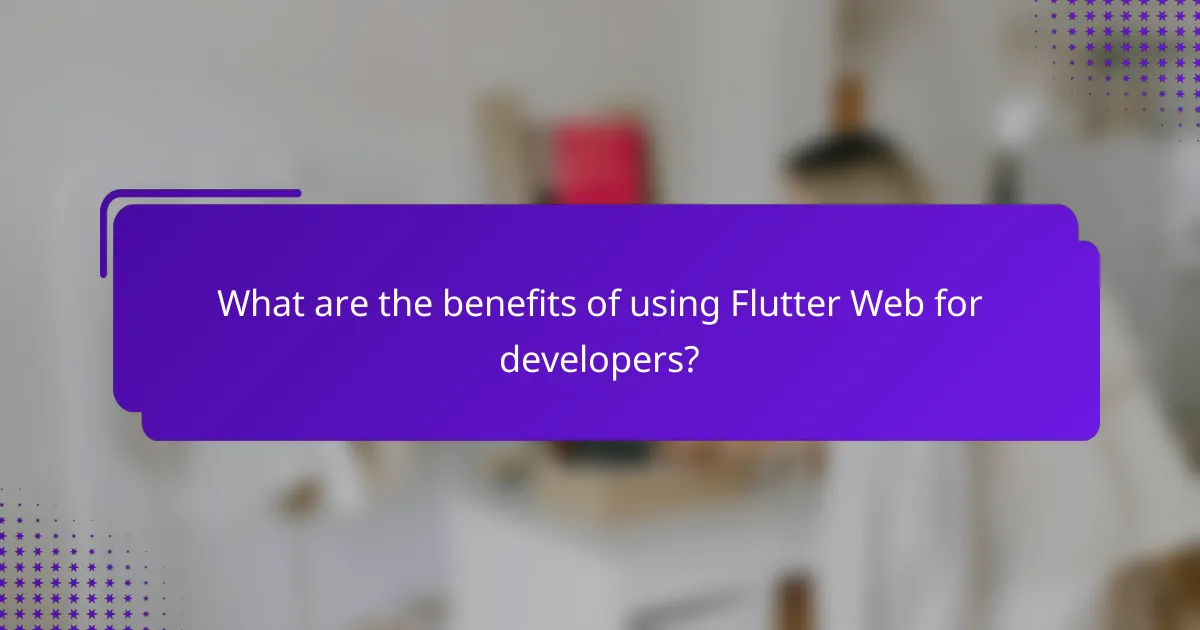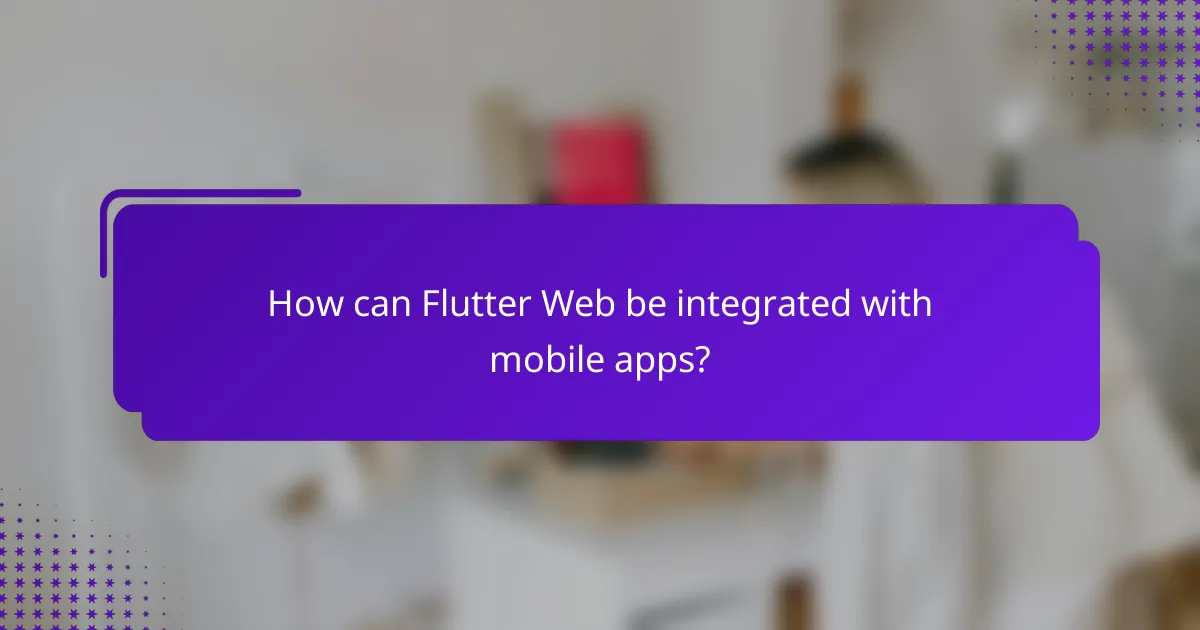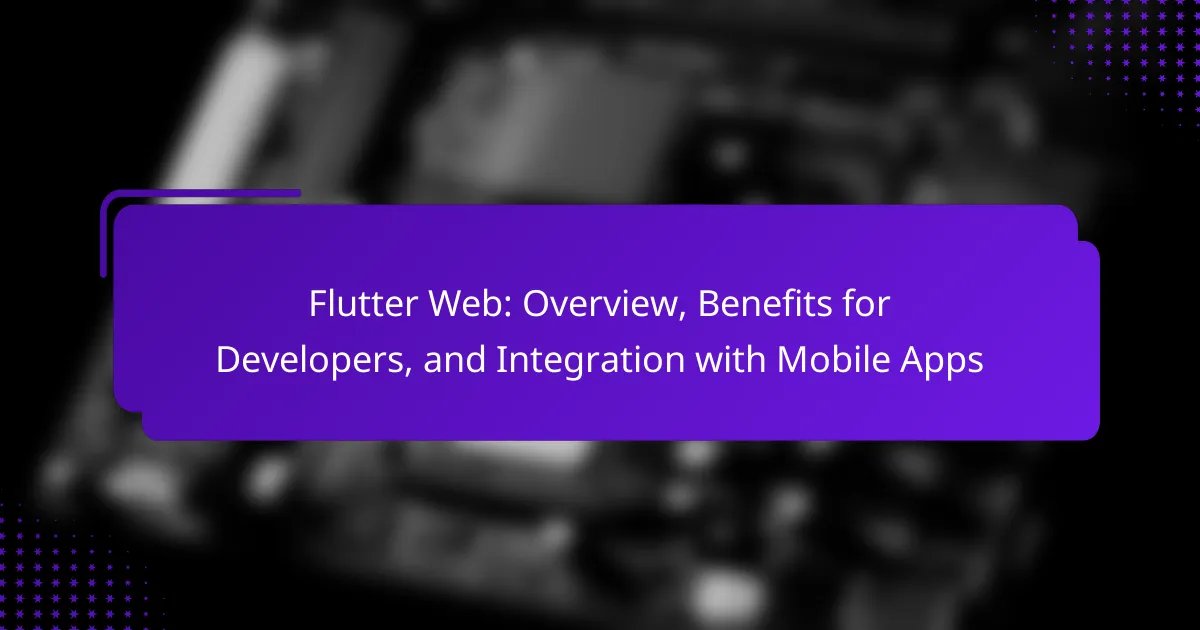Flutter Web is a framework designed for building web applications using the Flutter SDK and Dart programming language. It enables developers to create responsive, high-performance web apps with a single codebase, streamlining the development process. Key benefits include reduced development time, a rich widget library for customizable user interfaces, and modern web standards support for enhanced compatibility. Additionally, Flutter Web applications can be deployed as Progressive Web Apps (PWAs), allowing for offline access and user engagement through push notifications. The framework also facilitates integration with mobile apps, promoting consistency across platforms while leveraging shared logic and components.

What is Flutter Web?
Flutter Web is a framework for building web applications using the Flutter SDK. It allows developers to create responsive, high-performance web apps with a single codebase. Flutter Web utilizes Dart programming language, enabling smooth animations and a rich user interface. The framework supports various web standards, ensuring compatibility across different browsers. Flutter Web applications can be deployed as Progressive Web Apps (PWAs). This capability enhances user engagement through offline access and push notifications. The framework is part of the broader Flutter ecosystem, which also includes mobile and desktop app development.
How does Flutter Web differ from traditional web development?
Flutter Web uses a single codebase for both web and mobile applications, unlike traditional web development which typically requires separate codebases. This allows for faster development and easier maintenance. Flutter Web employs a widget-based architecture, enabling developers to create responsive UIs more efficiently. Traditional web development often relies on HTML, CSS, and JavaScript, which can lead to more complex integration processes. Additionally, Flutter Web compiles to native code, enhancing performance compared to the interpreted nature of traditional web technologies. These differences make Flutter Web particularly beneficial for developers looking to streamline their workflow across platforms.
What are the key features of Flutter Web?
Flutter Web enables developers to build responsive web applications using a single codebase. It allows for seamless integration with existing Flutter mobile applications. Flutter Web supports rich user interfaces with customizable widgets. The framework provides fast performance through its compilation to JavaScript. Hot reload functionality allows for quick iterations during development. Flutter Web is built on the same architecture as Flutter for mobile, ensuring consistency. It also includes access to a vast library of packages and plugins. Cross-platform capabilities allow for deployment on various browsers without modifications.
How does Flutter Web utilize Dart programming language?
Flutter Web utilizes the Dart programming language to build interactive web applications. Dart compiles to JavaScript, enabling Flutter Web to run seamlessly in web browsers. It provides a rich set of libraries and tools that enhance the development process. Dart’s asynchronous programming model allows for smooth user experiences. Flutter’s widget-based architecture leverages Dart’s features for creating responsive layouts. The hot reload feature in Flutter is powered by Dart, allowing developers to see changes instantly. Dart’s strong typing helps catch errors early in the development phase. Overall, Dart is integral to Flutter Web’s performance and developer productivity.
What are the use cases for Flutter Web?
Flutter Web is used for creating responsive web applications. It allows developers to build applications that run seamlessly across multiple platforms. Use cases include building single-page applications (SPAs) with smooth transitions. Flutter Web can also be utilized for e-commerce platforms that require dynamic content updates. Additionally, it is suitable for progressive web applications (PWAs) that offer offline capabilities. Organizations leverage Flutter Web for internal tools and dashboards, enhancing productivity. The framework supports real-time collaboration applications, enabling users to work together efficiently. Overall, Flutter Web caters to diverse web development needs with its robust features.
Which types of applications are best suited for Flutter Web?
Flutter Web is best suited for single-page applications, progressive web apps, and content-heavy websites. These applications benefit from Flutter’s fast rendering and efficient performance. Flutter Web’s capability to create responsive layouts is ideal for apps that require a seamless user experience across devices. Additionally, applications with rich animations and interactive features thrive in Flutter Web’s environment. The framework allows for rapid development and easy integration with existing web services. Its strong community support further enhances the development process, making it suitable for various web applications.
How can Flutter Web enhance user experience?
Flutter Web enhances user experience by providing a seamless and responsive interface across various devices. Its single codebase allows developers to create applications that function consistently on both web and mobile platforms. This reduces development time and ensures uniformity in design and functionality. Flutter’s widget-based architecture enables high customization and flexibility in UI design. Additionally, it supports hot reload, allowing developers to see changes in real-time without restarting the application. Performance is optimized through direct compilation to JavaScript, leading to faster load times. These features collectively contribute to an engaging and efficient user experience.

What are the benefits of using Flutter Web for developers?
Flutter Web offers several benefits for developers. It enables a single codebase for both web and mobile applications. This reduces development time and effort. Flutter’s rich widget library allows for highly customizable UI designs. Developers can create responsive layouts that adapt to different screen sizes. The hot reload feature enhances productivity by allowing real-time updates. Flutter Web also supports modern web standards, improving compatibility. Additionally, it provides excellent performance due to its compiled nature. These benefits collectively streamline the development process and enhance user experience.
How does Flutter Web improve development efficiency?
Flutter Web improves development efficiency by enabling a single codebase for multiple platforms. This reduces the time and effort required for development. Developers can write code once and deploy it across web and mobile. The hot reload feature allows real-time updates during the development process. This accelerates testing and iteration cycles significantly. Flutter Web also offers a rich set of pre-built widgets. These widgets simplify the UI design process, allowing developers to focus on functionality. Additionally, Flutter’s performance optimizations enhance load times and responsiveness. Overall, these features contribute to a more streamlined development workflow.
What tools and resources are available for Flutter Web developers?
Flutter Web developers have access to a variety of tools and resources. The Flutter SDK is essential for building web applications. It includes a rich set of pre-built widgets and libraries. Developers can use Dart, the programming language behind Flutter, for coding. Visual Studio Code and Android Studio are popular IDEs for Flutter development. The Flutter DevTools suite provides debugging and performance analysis tools. Online resources include the official Flutter documentation and community forums. GitHub hosts numerous open-source Flutter projects for reference. Additionally, platforms like Stack Overflow offer community support for troubleshooting.
How does Flutter Web facilitate cross-platform development?
Flutter Web facilitates cross-platform development by enabling developers to write a single codebase that runs on multiple platforms, including web, mobile, and desktop. This approach streamlines the development process and reduces the time needed for deployment. Flutter uses the Dart programming language, which compiles to native code. This results in high performance across different devices. Additionally, Flutter’s widget-based architecture allows for a consistent UI experience on all platforms. The framework includes a rich set of pre-designed widgets that adapt to different screen sizes and resolutions. This flexibility supports responsive design principles. Furthermore, Flutter Web integrates seamlessly with existing web technologies, enhancing its usability for web-based applications. Overall, Flutter Web’s capabilities significantly enhance cross-platform development efficiency and effectiveness.
What advantages does Flutter Web offer in terms of performance?
Flutter Web offers several performance advantages, including fast rendering and efficient resource utilization. It compiles to native code, which enhances its execution speed. The framework uses a Skia-based rendering engine, enabling smooth graphics and animations. Flutter Web also supports hot reload, allowing developers to see changes instantly without restarting the app. This feature accelerates the development process and reduces time spent on debugging. Additionally, Flutter Web’s architecture minimizes the need for additional JavaScript, leading to faster load times. Overall, these performance features contribute to a fluid user experience and efficient development workflow.
How does Flutter Web handle rendering and animations?
Flutter Web handles rendering and animations using a combination of the Skia graphics engine and the Dart programming language. The framework compiles Dart code to JavaScript, enabling high-performance rendering in web browsers. Flutter Web employs a widget-based architecture, allowing developers to create complex UIs with ease.
Animations are managed through the use of the Animation and AnimationController classes, which provide fine control over animation duration and behavior. The rendering process utilizes a tree structure that efficiently updates only the parts of the UI that change. This results in smooth transitions and responsive interactions.
Flutter Web’s rendering is optimized for different browsers, ensuring consistent performance across platforms. The framework supports both 2D and 3D graphics, enhancing the visual experience. Overall, Flutter Web provides a robust system for rendering and animations, leveraging modern web technologies for optimal performance.
What are the benefits of hot reload in Flutter Web?
Hot reload in Flutter Web provides immediate feedback during development. It allows developers to see changes in real-time without restarting the application. This significantly speeds up the development process. Developers can quickly iterate on UI designs and functionality. It enhances productivity by reducing the time spent on repetitive tasks. Hot reload maintains the app’s state, allowing for seamless testing of features. Studies show that this feature can reduce development time by up to 30%. Overall, hot reload is a crucial tool for efficient Flutter Web development.

How can Flutter Web be integrated with mobile apps?
Flutter Web can be integrated with mobile apps using a single codebase. This allows developers to create web applications that share the same logic and UI components as their mobile counterparts. By leveraging Flutter’s widget system, developers can ensure consistency across platforms. The integration is facilitated through Flutter’s web support, which compiles Dart code to JavaScript. Developers can use the same libraries and packages for both mobile and web applications. This approach reduces development time and maintenance efforts. Additionally, Flutter’s hot reload feature enhances the development experience by allowing real-time updates. This integration strategy promotes a seamless user experience across devices.
What are the best practices for integrating Flutter Web with existing mobile applications?
The best practices for integrating Flutter Web with existing mobile applications include maintaining a shared codebase, utilizing responsive design, and implementing feature flags. A shared codebase allows developers to write code once and deploy it across platforms, enhancing efficiency. Responsive design ensures that the application adapts to various screen sizes, providing a seamless user experience. Feature flags enable developers to toggle features on and off, facilitating testing and gradual rollouts. Additionally, leveraging existing components and libraries from the mobile app can expedite the integration process. Regular testing across devices and browsers is crucial to ensure compatibility and performance. These practices lead to a more streamlined integration process and improved application quality.
How can developers ensure a seamless user experience across platforms?
Developers can ensure a seamless user experience across platforms by utilizing responsive design principles. This approach allows applications to adapt to various screen sizes and orientations. Developers should implement a consistent user interface across devices. This includes using the same color schemes, fonts, and button styles. Additionally, optimizing performance is crucial. Fast load times and smooth interactions enhance user satisfaction. Developers can leverage Flutter’s capabilities to share code between web and mobile platforms. This reduces discrepancies in functionality and design. Testing across different devices and browsers is essential. It helps identify and resolve any issues that may arise. By following these practices, developers can create a cohesive user experience across platforms.
What tools assist in the integration process between Flutter Web and mobile apps?
Flutter provides several tools to assist in the integration process between Flutter Web and mobile apps. These tools include Flutter’s own framework, which allows for a unified codebase across platforms. Dart DevTools offers debugging and performance profiling, enhancing the integration experience. Additionally, Flutter’s package ecosystem, such as the `flutter_web` package, aids in creating web-compatible applications. Firebase can be used for backend services, facilitating data synchronization across platforms. Lastly, tools like Visual Studio Code and Android Studio provide robust development environments for cross-platform integration. These tools collectively streamline the integration process, ensuring a cohesive experience across Flutter Web and mobile applications.
What challenges might developers face during integration?
Developers may face several challenges during integration with Flutter Web. One significant challenge is compatibility with existing codebases. Legacy systems may not align with Flutter’s architecture. This can lead to increased development time and complexity. Another challenge is managing state across different platforms. Ensuring consistent user experiences can be difficult. Performance issues may arise, especially with large applications. Developers must optimize for web performance, which differs from mobile. Additionally, debugging can be more complex in a web environment. Tools and resources for Flutter Web are still evolving, which can hinder efficiency. These challenges require careful planning and testing to overcome.
How can developers troubleshoot common integration issues?
Developers can troubleshoot common integration issues by systematically identifying and resolving errors. First, they should review error logs for specific messages. These logs often highlight the root cause of the problem. Next, developers can check the API endpoints for correct URLs and parameters. Ensuring that the endpoints are accessible is crucial for successful integration.
Another step is to validate data formats being exchanged between systems. Mismatched formats can lead to failures in data transmission. Developers should also test the integration in different environments. This includes staging and production settings to isolate issues.
Additionally, using debugging tools can help trace the flow of data. Tools like Postman or browser developer tools can provide insights into requests and responses. Collaborating with team members can also bring fresh perspectives on persistent issues.
Lastly, reviewing documentation for both Flutter and the integrated services can reveal overlooked details. Following these steps can significantly enhance the troubleshooting process for integration issues.
What tips can enhance the integration of Flutter Web with mobile apps?
To enhance the integration of Flutter Web with mobile apps, developers should prioritize responsive design. This ensures that the UI adapts seamlessly across different screen sizes. Utilizing shared codebases is also crucial; it allows for consistent functionality and reduces duplication. Implementing platform-specific adaptations can improve user experience by leveraging native features. Additionally, testing across devices is essential to identify and resolve integration issues promptly. Regular updates to dependencies and Flutter versions help maintain compatibility. Lastly, leveraging Flutter’s web capabilities, such as Progressive Web Apps, can enhance accessibility and performance.
Flutter Web is a framework designed for building responsive web applications using the Flutter SDK and Dart programming language. The article provides an overview of Flutter Web, highlighting its key features, benefits for developers, and how it integrates with mobile applications. It discusses the differences between Flutter Web and traditional web development, the advantages of a single codebase, and the performance benefits offered by the framework. Additionally, the article outlines best practices for integration with existing mobile apps, common challenges developers may face, and tips to enhance the integration process.
